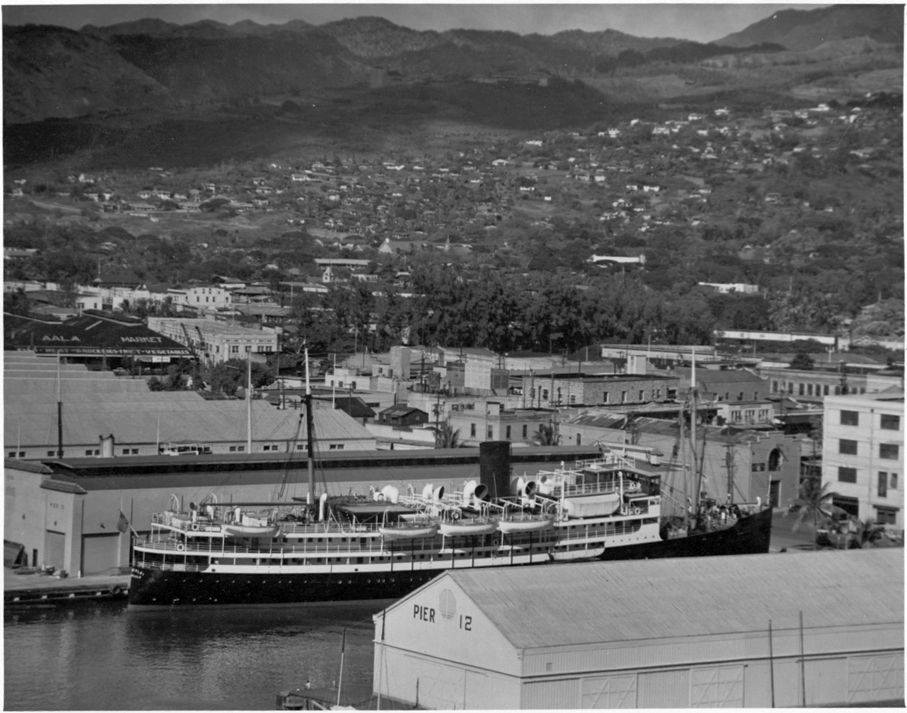Aviation history for Lānai began with the creation of an emergency landing strip, there, in 1919. Aviation use was on-again, off-again in different areas of the island for the next few decades.
In its 1928 Annual Report, the Territorial Aeronautical Commission reported the excellent cooperation of the Hawaiian Pineapple Company, in making a suitable field available for emergency airplane landings on the Island of Lānai. The field was at Leinukalahua, Kaʻa.
Things got official in 1928, when Inter-Island Airways (now Hawaiian Airlines) began operations to Lānai with Sikorsky S-38 eight-passenger amphibious planes. The landing field was owned by the Hawaiian Pineapple Company.
In July 1930, the Territorial Aeronautics Commission wrote to Hawaiian Pineapple Company asking if they wished to apply for a license for their field. There was no response.
During 1935, Inter-Island Airways started to replace its 8-passenger planes with 16-passenger planes, which were later (1941) replaced by 24-passenger Douglas DC-3s.
The Lanai field was not big enough to accommodate this type of aircraft and once the last of the S-38s were put out of service (shortly after the start of World War II,) air service to Lānai came to a halt.
In 1944, the Post War Planning Division of the Territorial Department of Public Works proposed to construct a new 5,000-foot runway and airport 4-miles southwest of Lānai City (Hawaiian Pineapple Company, Ltd was looking to about 220-acres for the new facility.)
“The existing airport is too small for two-engine planes, and the Civil Aeronautics Administration has advised that it is willing to consider an application for a major airport,” the Public Works report stated.
“The dependence of the population upon air service justifies the proposed project. The part of the Lānai pineapple plantation in the Territory’s economy is very great. The present airport, although in operation, is unpaved and is in great need of adequate paving to prevent erosion from severe winds and relatively high rainfall.”
A new airport site for Lānai was chosen and on September 18, 1946, Hawaiian Airlines resumed service there using its DC-3s. The unpaved sod strip field was practically unusable in wet weather and almost untenable due to dust and dirt in dry weather. In view of these conditions, air service was not reliable and it was therefore decided to pave the runway and taxiway.
A Master Plan was prepared (1946) that called for a single 4,200-foot runway. The Territorial Legislature appropriated one-third of the funds, with the rest matched by Civil Aeronautics Administration funds. In 1947, Lānai Airport management was put under the Hawaii Aeronautics Commission.
The 3,700 feet long runway and related facilities, the first field constructed by the Hawaiian Aeronautics Commission, was officially dedicated on July 12, 1948.
By 1950, the airport was served regularly by Hawaiian Airlines with twice daily passenger service in two directions and twice weekly freight service. Air mail service was supplied.
Over the years, additions were made to the facility. In 1960, the Maui County Board of Supervisors requested both the State and Hawaiian Airlines to use larger more modern aircraft to provide passenger air service to Lānai. (Hawaiian had changed its fleet from DC-3s to Convairs.)
A new Master Plan called for extension of the runway to a total of 5,000-feet, as wells as new terminal facilities to match the requirements of the newer planes. The new projects were completed and dedicated on October 16, 1966.
On October 1, 1979, the Civil Aeronautics Board Order 79-10-3, the Bureau of Domestic Aviation, defined essential air service for Lānai as follows: “Lānai: A minimum of two daily round trip flights to Honolulu and Kahului providing a total of at least 80 seats in each direction per day.”
After minor upgrades, the airport went through another expansion phase. Dedicated April 19, 1994, the new single-story 15,000-square foot terminal was five times larger than the existing and included space for a gift shop and food and beverage concessions and counter space for six airlines.
The Lanai Airport Master Plan Update was published in June 1999. Phase I of the proposed improvements (2000-2010) called for improvements to the airfield, terminal complex, and design, planning, project management and contingency costs.
Larry Ellison bought about 98 percent of the island of Lānai in June 2012; Ellison announced plans to extend the runway by 500 feet so larger planes could land there. (Lots of information from hawaii-gov.)































































